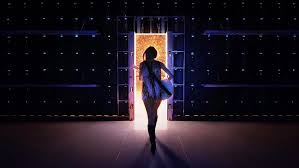Doogie Kamealoha, M.D. Review 2021 Tv Show Series Cast Crew Online
Doogie Kamealoha, M.D., the newest addition to Disney+’s already robust slate of nostalgic ‘90s(ish) revamps, isn’t *exactly* Return of the (Andi) Mack, but you’d be forgiven if you happened to forget that within the first five minutes of the pilot.
I don’t just say this because both series star the magnetically effervescent Peyton Elizabeth Lee, although that’s obviously a factor. Rather, I say it because while the first episode of Doogie Kamealoha, M.D. opens with Lahela (Lee) marking a milestone birthday (16) by trading her old bicycle in for a hot new driver’s license, the first episode of Andi Mack opened with Andi (also Lee) marking a milestone birthday (then 13) by… trading her old bicycle in for a hot new moped. Does Lahela, like Andi, then spend the bulk of her birthday distracted by her crush, who just so happens to partake in the chillest local sport imaginable (ultimate frisbee for Jonah in Salt Lake, surfing for Walter in O’ahu)? Of course she does. And does Lahela, like Andi, follow that by filling whatever time’s left in the episode with being at emotional war with her stricter parent but at peace with her cool one? Of course she does!
On their own, a few surface-level parallels between Doogie Kamealoha, M.D. and Andi Mack would make for a fun bit of trivia, in the end the two series bear little actual resemblance to one another: Andi is about a tween artist coming to terms with the revelation that her cool older sister is actually her mom, and Doogie is about a teen medical prodigy juggling her Sweet Sixteen social life with her serious responsibilities as a working doctor.
The thing is, as a revamp of 1989’s Neil Patrick Harris-starring Doogie Howser, M.D. (created by the late Steven Bochco and David E. Kelley), Doogie Kamealoha, M.D. (developed and showrun by Kourtney Kang, with Kelley back as producer) is surfing in on a whole different set of parallels—ones that go way deeper than just the surface. To wit: In Doogie Howser, M.D., the original Doogie (Harris) is a 16 year old prodigy who finished high school in nine weeks and got his medical license at age 14. Lee’s Lahela, in Doogie Kamealoha, M.D.? Same. See also the fact that both have a doctor parent (Doogie’s dad being in charge of a family practice; Lahela’s mom being in charge of their entire hospital), and an aggressively boorish “normie” best friend who serves as their out-of-hospital foil (Vinnie Delpino for the OG Doogie; Steph Denisco for Lahela). Plus, both lean on cutting-edge technology to chronicle the lessons they learn each episode, both in the hospital and out (the OG Doogie via computer diary; Lahela on YouTube/TikTok).
The biggest difference, really—well, aside from the fact that the OG Doogie was a white boy from Los Angeles, while Lahela is a half Korean, half white girl from O’ahu (both identities, relevantly, reflected by the series’ respective showrunners)—is that Doogie Kamealoha, M.D. takes place in a world in which the original Doogie Howser, M.D. also aired. This means that Doogie, in his original fictitious incarnation, can (and does, to Lahela’s endless annoyance) serve as convenient shorthand for both Lahela’s patients and her colleagues. This is very fun! When specific callbacks are needed, Doogie Howser’s in-world existence makes them easy to pass off as more or less organic. When the story needs Lahela to distinguish herself from the OG (and made-up) Doogie, though, that gets to feel organic, too.
Unfortunately, in being as self-aware as it is about using so many of the tropes/story beats established by Doogie Howser, Doogie Kamealoha inadvertently opens itself up to being compared to all the other ‘90s and ‘00s shows it’s pulling from for so many of its other tropes/story beats—comparisons it rarely wins. On the hospital side of things, for example, Doogie Kamealoha is doing solid work marrying comedy with pathos, but it suffers from the simple fact that Scrubs exists. In the pilot, it’s affecting to see Lahela deal with her first on-the-job tragedy, and the monologue her mom delivers when it happens—with the snack machine and the pretzels and sudden, choking sobs—that’s great. But it will be impossible for just about any adult watching to not see that tragedy coming, and, as a result, to not find the heart-twisting virtuosity of similar tragedies weathered by J.D. two decades ago at the top of their mind.
On the teen girl side of things, meanwhile, Doogie Kamealoha is hitting all the classic marks: a cute crush that a dad can menace before a big dance; a quirky best friend who climbs in through the bedroom window at all hours of the day and is embarrassingly obsessed with your lead character’s older brother; an obsession with how things look vs. how things are. But while it knows well enough how to employ these tropes, Doogie Kamealoha is (at least thus far) doing so without managing to say anything even on par with the likes of Clarissa Explains it All, Boy/Girl Meets World or To All the Boys I’ve Loved Before, let alone anything new. Honestly, even the most anodyne ostensible Teen Girlisms are written with such unmoored awkwardness that it’s impossible even for Lee, with all her teen girl acting experience, to make them sound natural. (“I got a case of going to a dance with a hottie!” being just one example of a thing that no teen girl, anywhere in all of history, has ever said without a heaping scoop of irony.)
Even more cringe, though, is everything going on with Lahela’s best friend, Steph (Emma Meisel), who’s been written with such a lack of sensitivity to or understanding of the nuances popular media has finally let teen girls have on screen in the past couple decades—even when they’re the comic relief!—that it seems almost willful. For one thing, across the two episodes provided for review, there was basically nothing to suggest any real depth or texture to Lahela and Steph’s friendship. It’s all patter, and contrived openings for Steph to “get to” aggressively flirt with creep on Lahela’s himbo brother, Kai (Matthew Sato). At one point, Steph’s “comedic” obsession with Kai gets so aggressive it verges on sexual assault. It’s not funny! It’s not funny, and it does nothing to progress Lahela’s out-of-hospital storyline, which is the top plot Steph should be playing a meaningful role in.
Look, there is a long and storied TV tradition of the weirdo friend climbing through the bedroom window, just as there is an equally long and storied tradition of an overeager best friend being in love with her BFF’s oblivious older brother. But sometimes the thing with long and storied traditions is that they’re not worth touching unless you have something new to say with them. In the case of Doogie Kamealoha, M.D., there’s nothing that the character of Steph Denisco does with either tradition that couldn’t be better served with literally anything else.
If all of this sounds like I’m down on Doogie Kamealoha, M.D., please know: I’m not. Aside from its disappointing lack of care for the complex richness of of teen girlhood (and, of course, the repellent emptiness of the Steph character), I genuinely enjoyed watching both of the episodes provided for review, and just as genuinely look forward to making the rest of the first season my weekly weekend wind-down. The warmth within the Kamealoha-Hannon ‘ohana is both palpable and endearingly natural, while the hospital stories, bolstered as they are with fun and funny performances from Mapuana Makia, Jeffrey Bowyer-Chapman, and a particularly sharp-tongued Ronny Chieng, strike a smart balance between comedy and pathos.
On a visual level, Doogie Kamealoha, M.D.’s inclination to shoot on (beautiful) location whenever humanly possible gives it an edge on pretty much everything else in the Disney+ comedy library. The natural light (and occasionally wind), the real O’ahu landscape in the background, the ocean—and so much of it filmed as though with a hand-held camera (the better to make it feel alive)—all of it is a useful balance to the plastic cheesiness inherent to the reboot family dramedy format. Said another way: If we’re going to be asked to believe that a 16 year old could be a practicing medical doctor (fake!), it helps to at least see that the world she lives in is full of sand and saltwater and low-clouded skies (real!)
Now, is Doogie Kamealoha, M.D. as raucously delightful as High School Musical: The Musical: The Series? No. But then again, it’s hard to imagine what could be. Compared to the rest of the teen-centric Disney+ originals currently on offer, though, it’s poised to at least match, if not top, The Mighty Ducks: Game Changers for sheer enjoyability. I mean, Lee is a smart, charismatic actor, one for whom Doogie Kamealoha, M.D. is pretty much a perfect vehicle. If the rest of Season 1 delivers on the promise its first two episodes make, it could easily establish itself as a comforting favorite for years to come.




